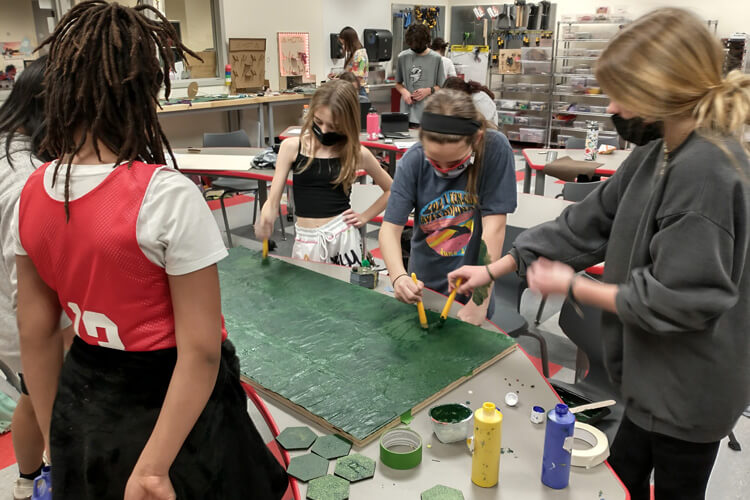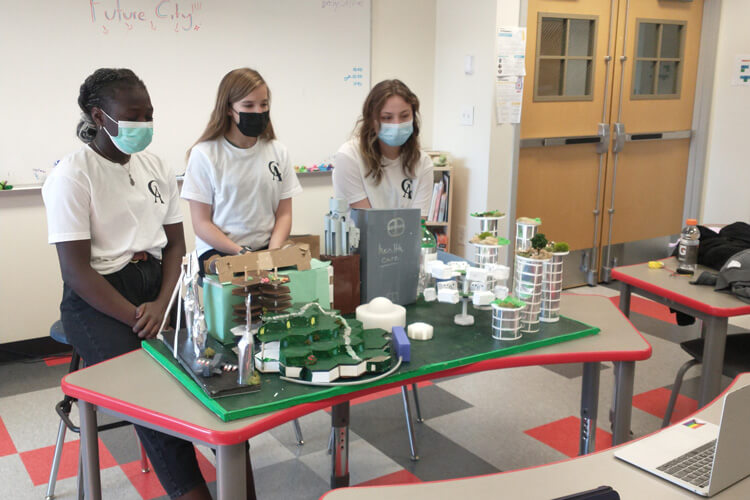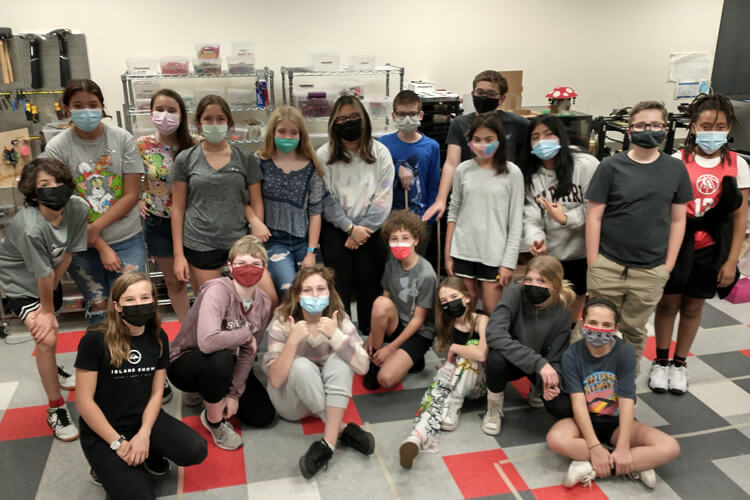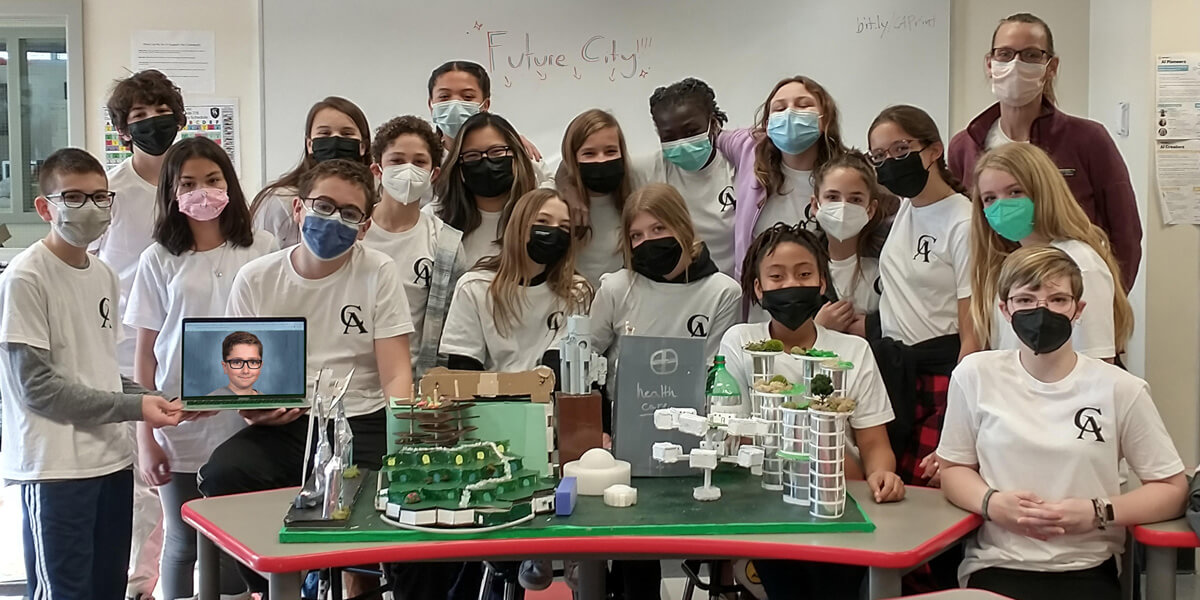After winning the Future City Regional Competition last year when they were in Seventh Grade, Colorado Academy’s Eighth Grade Future City team leaders Kate Freeman and Adam Marwan didn’t think they had much of a chance of repeating the win this year.
“I figured they couldn’t possibly give it to us two years in a row,” says Kate. “We would have to be head and shoulders above everyone else.”
Apparently, the Future City team’s plan for a waste-free Thunder Bay, Ontario, reliant on circular economy principles, was exactly that, because the team brought back first place honors for a second year in a row. The competition was held via Zoom. They also won awards for Best Essay, Best Project Management, and Best Materials and Food Resources. They will now head to the national competition, which includes teams from 36 regions, to be held via Zoom in February.
“They had to consider how anything and everything could be used or reused or kept in circulation, instead of being dumped into a landfill,” says Middle School Science teacher Kathleen Kirkman, a faculty sponsor along with Educational Technology Specialist Laura Farmer. “They worked so hard and really put their heart and soul into it.”

In fact, this Middle School team of Seventh and Eighth Graders was so determined that, on a day when school was canceled because of a power outage, they came to school anyway. Kirkman found a room with heat and phone service, and students invested more than seven hours of work—on a day with no school!—to meet a big deadline.
“Ms. Farmer is a 3D printer master and a laser printer queen,” says Adam. “But we couldn’t use the laser printer or the 3D printer. We had to find ways to build the city without power.”
“Natural light did its job, and it was one of our best days,” Kate adds, with a laugh.
The team’s plan may go straight to city officials in Thunder Bay—a case study of what happens when Middle School ingenuity and CA networking combine to help save the planet.

Lightning and thunder energy
The team was required to fulfill five deliverables for the competition, including an essay, a project plan, a scale model, a video presentation, and a Q & A session with judges.
“Those questions are a little like defending your PhD dissertation,” Kirkman laughs, “only at the Middle School level.”
CA students picked Thunder Bay because it is a “climate haven,” meaning there is low risk of its being destroyed by the various environmental impacts of climate change in the next 100 years. With thoughtful intervention, the city could become even “greener.”
Kate, who confesses that she started thinking about this year’s Future City competition as soon as last year’s ended, is particularly proud of the “lightning farm” that students designed to capture energy from lightning to power the city.
“We could create lightning through cloud seeding,” she says. “Lightning creates so much energy that we had a serious electrical surplus, which we could transport to other cities that are not as green as we are.”
Adam liked their plan to create sound energy from panels in the ground that act as sound sponges and absorb the energy, “turning kinetic energy into electric energy.”
Kirkman arranged for the students to meet with David Kiefner, the owner of The Happy Beetle, a company that specializes in door-to-door pick-up of hard to recycle items. He introduced the team to the economics of eliminating waste.
“Listening to him, the kids figured out that it’s cheaper and easier [for manufacturers] to make things that are designed to be thrown away,” says Kirkman. “They realized you can’t just design to get rid of waste—you have to start with the way products are designed.”
These budding city planners came up with a solution—smart bins—waste disposal bins that would read a microchip in discarded products and send them back to the company that made them to incentivize their reuse in new products. If companies refused, they planned to hit them on their bottom line, taxing them heavily on new raw materials.

The Thunder Bay connection
Word spread throughout the Middle School that the students were studying Thunder Bay. Middle School parent Joanne Esposito, who had lived in the city for many years, generously shared her time with the students, giving them insider tips and providing context for their ideas. When the project was finished, she asked permission to show it to the Thunder Bay City Council so, Kirkman says with a chuckle, “They may hear our grand plan for redesigning their city.”
Both Kate and Adam say that, even though the Future City work is done outside the classroom (twice a week after school since September), there is plenty of learning going on—particularly in the areas of math and writing. But they also agree that the overarching lesson may be what they call “social learning.”
“You have to work with other people,” Kate says. “You can’t fly solo.”
Kirkman says she is impressed with the “meaningful learning” that takes place on the Future City team. “They feel ownership because this is their city,” she says. “They have to design every aspect of what it would be like to live, work, or go to school there. They can correct mistakes that adults are making in the world now. They can imagine a better world, and it’s entirely theirs.”
Congratulations to all members of the Future City Team: Seventh Graders Aubrey Armstrong, Nylmah Bryant, Mckenna Farrell, Kobe Glesser, Peter Hedstrom, Mila Hudson, Alegría Monterroso, Nina Oren, Maria Jose Seitz-Yanez, Nora Trembath, and Ben Zinn; and Eighth Graders Kaley Chavez, Chloe Chesley-Vogels, Hashem Elprince, Kate Freeman, Isabel Gottlieb, Mara Harris, Alix Koren, and Adam Marwan.
